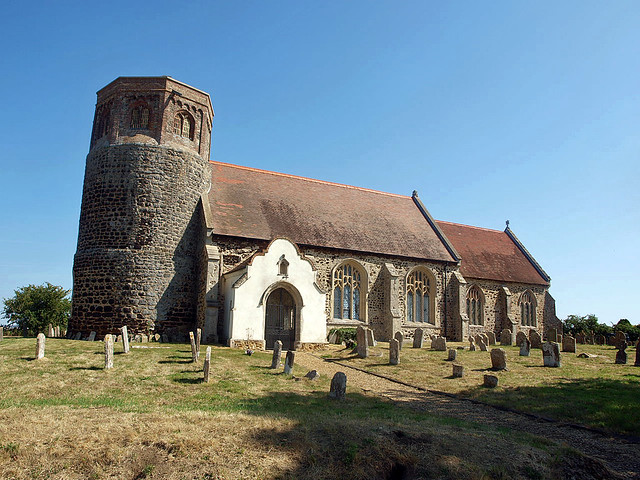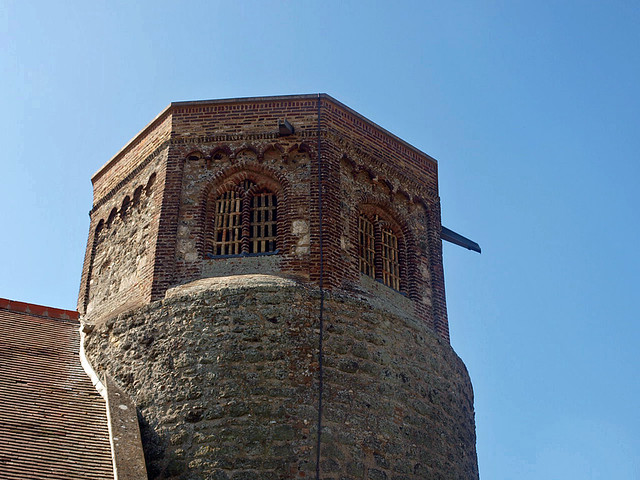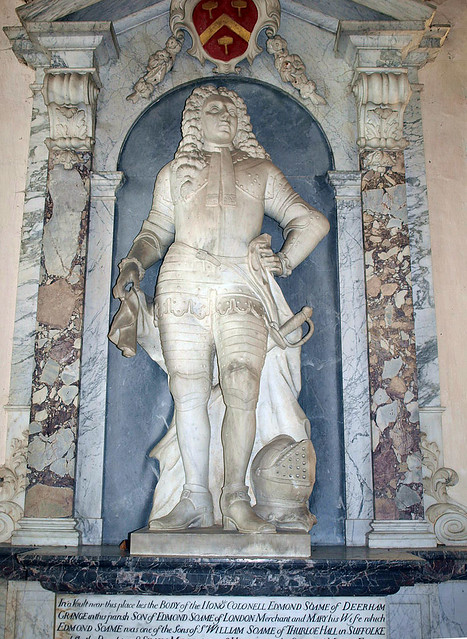ST ANDREW. Round tower of big carstone blocks. The tower is of exceptional circumference (inside I7 ft 6 in.). Remains of the wide Norman arch towards the nave. Very pretty octagonal brick top with brick bell-openings and a frieze of little round arches. The S doorway to the nave is of c. 1200 or a little later. Pointed arch with many mouldings and one order of shafts. The rest mostly Perp. The nave windows with stepped transoms, the chancel windows with two-centred arches. C17 S porch gable. - FONT. Octagonal, Perp, with quatrefoils. - PULPIT. Elizabethan or Jacobean, with the usual stubby blank arches. - COMMUNION RAIL. Late C17, three-sided, with twisted balusters. - BIER. Dated 1683, but still in pre-classical forms. - STAINED GLASS. Original fragments in the E and one nave S window. - MONUMENTS. Robert Dereham d. 1612 and his father. Tablet without figures. - Sir Thomas Dereham d. 1722. Tablet of variously coloured stone with coat of arms against a leaf background. Very decorative, though somewhat conservative. - Col. Edmund Soames d. 1706. Signed by Robert Singleton of Bury St Edmunds. Standing white figure in armour against classical architectural background of white, grey, and pink marble. Mr Gunnis rightly calls it 'an exciting and remarkable work'.
WEST DEREHAM. On Abbey Farm are traces of the abbey founded here late in the 12th century by Hubert Walter, who was born in the village. He went to Palestine with Richard Lionheart, who made him Archbishop of Canterbury, and he proved himself a strong prelate who could hold King John in check.
The church of the abbey is now a storehouse and a barn, but such menial offices cannot rob it of its dignity or its standing as a footnote to history. The archbishop lies in Canterbury, and it was long after his day that Thomas Tusser of Essex, the literary farmer who wrote Five Hundred Pointes of Good Husbandrie, came to live at Abbey Farm and put some of his points into practice. Norman statesman and 16th-century husbandman meet here on common ground.
At the break-up of the monasteries the abbey and its lands were granted to the old family of Dereham, one of whom was Francis Dereham, kinsman of Queen Katherine Howard and one of Henry the Eighth’s victims. Memorials to Robert Dereham of 1612 and Thomas of 1723 are in the church, which stands on the little hill beyond the cottages and once had a companion church in the same churchyard. Another memorial is a marble figure in armour, keeping green the memory of Colonel Edmund Soame who fought in Ireland for William of Orange. The Normans built the sturdy round tower, which the 15th century crowned with an octagonal belfry of arcaded brick. The south doorway is 13th century; the 15th-century nave and chancel have been restored.
Fragments of old glass dotted about the east window, and a jumble of others in the nave, are said to have come from the abbey. The roodstairs and doorways are still here, with the medieval font and the Jacobean pulpit.
As old Thomas Tusser spent here some of the years when he was writing his quaint books for tillers of the soil, the plough being his music, as he said, we may here remind ourselves of the quaint epitaph he wrote for himself:
Here Thomas Tusser, clad in earth, doth lie,
Who sometime made the Points of Husbandry:
By him, then, learn thou may’st, here learn we must,
When all is done, we sleep, and turn to dust:
And yet through Christ to heaven we hope to go,
Who reads his books shall find his faith was so.
The church of the abbey is now a storehouse and a barn, but such menial offices cannot rob it of its dignity or its standing as a footnote to history. The archbishop lies in Canterbury, and it was long after his day that Thomas Tusser of Essex, the literary farmer who wrote Five Hundred Pointes of Good Husbandrie, came to live at Abbey Farm and put some of his points into practice. Norman statesman and 16th-century husbandman meet here on common ground.
At the break-up of the monasteries the abbey and its lands were granted to the old family of Dereham, one of whom was Francis Dereham, kinsman of Queen Katherine Howard and one of Henry the Eighth’s victims. Memorials to Robert Dereham of 1612 and Thomas of 1723 are in the church, which stands on the little hill beyond the cottages and once had a companion church in the same churchyard. Another memorial is a marble figure in armour, keeping green the memory of Colonel Edmund Soame who fought in Ireland for William of Orange. The Normans built the sturdy round tower, which the 15th century crowned with an octagonal belfry of arcaded brick. The south doorway is 13th century; the 15th-century nave and chancel have been restored.
Fragments of old glass dotted about the east window, and a jumble of others in the nave, are said to have come from the abbey. The roodstairs and doorways are still here, with the medieval font and the Jacobean pulpit.
As old Thomas Tusser spent here some of the years when he was writing his quaint books for tillers of the soil, the plough being his music, as he said, we may here remind ourselves of the quaint epitaph he wrote for himself:
Here Thomas Tusser, clad in earth, doth lie,
Who sometime made the Points of Husbandry:
By him, then, learn thou may’st, here learn we must,
When all is done, we sleep, and turn to dust:
And yet through Christ to heaven we hope to go,
Who reads his books shall find his faith was so.



No comments:
Post a Comment